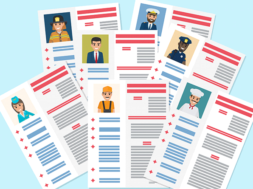
Career Services in a Trump World: Make it Great Again
By Jarlath O’Carroll, Founder, Jobspeaker
Education institutions have the opportunity to achieve better outcomes in career placement for the out-going student. Now more than any other department, career services is front and center in the demands being put on institutions. And this pressure is unlikely to change with the new Trump administration. In fact, it may even increase as the new administration looks to fulfill its mandate to “Make America Great Again,” which many interpret as getting people jobs and better-paying jobs again.
How this will be done will likely vary from accreditation agency to regulatory body, to state government, but the overall goal of “education for jobs” is not going to change.
Career Services has seen additional pressures and complexity added to an already challenging role. Any new initiatives from the incoming administration will likely do the same. Most Career Services do not have the resources to respond (or if they do it’s very labor intensive). As a result, very few institutions can cope with the workload these changes demand.
Career Services needs more support, more resources, and more investment to be able to respond to this new world.
To understand what’s happening let’s look at what has driven some of these changes, particularly over the last few years. As a result of the Great Recession, a great number of things have changed. In the early years of the recession, recruiting new students into many institutions was straightforward as they looked to gain new skills. But as the recession dragged on recruiting students into education became more difficult and pressures began to mount to show better outcomes for students. At the same time, as the U.S. slowly recovered the job market changed, employers were hiring for new skills and could afford to be picky. Graduates found themselves in a challenging job market where their skills were difficult to map to new jobs, and they grasped for jobs to earn a living.
Career services were decimated during the Great Recession particularly in public institutions where budgets were slashed. In most colleges, career services or services to help the student enter the job market were less valued than the recruitment services to get students to enter and stay at the institution.
The Gainful Employment Rule (July 1, 2015)1 has put significant pressure on proprietary institutions. The millennial population is now larger than the baby boomer population2 and they have different priorities than previous generations. In particular, they are very resistant to going into debt for an education without some guarantees of a good career. Plus they are very technology-savvy and expect services on their mobile devices where they interact with the rest of their world.
As a result of these significant changes, most career services departments do not have the capability to deliver against these imperatives. Some career services departments today are responding to these challenges by adding more people to their teams. They are using a smattering of tools to provide a variety of services while manually collecting data and producing reports. A career service member’s time is now spent more on data collection and reporting than on actually providing career advice.
Figure 1: How career service time needs rebalancing
However, there is hope, as a new generation of technology services are entering the market to respond to these needs. They will enable career services to leverage the capabilities of their existing team, empower their students and expand their interaction with employers. By effectively utilizing these tools, career services can be more effective in achieving better outcomes for their students and remove the overly weighted burden of data gathering and reporting.
To respond to the need in the market appropriately, these new technologies should offer a suite of services that will deliver a comprehensive solution to colleges. It should contain the following:
Figure 2: The pillars of the career services student success continuum
1. Career preparation is a series of classes delivered throughout the students’ experience by a variety of faculty to help better prepare them for the job market. Career services can assist in this process by:
- Ensuring students have a career goal and a defined path to achieve their goal.
- Ensuring students are picking the right programs based on their career preferences.
- Ensuring students are developing employability skills (e.g., communications, teamwork, etc.) not just the hard skills.
- Ensuring they are prepared for the job search, know what to expect, and are sufficiently empowered to run an efficient and effective job search.
This content can be delivered in a variety of ways, but with today’s student, especially millennials, this content needs to be delivered on their mobile device so they can access it when and wherever they need it.
2. Career advisory is providing the student the right guidance based on their chosen profession and to be better prepared for that job upon graduation. Modern career services will need to be proactive and efficient through enabling:
- Assessment tools that identify the specific weaknesses that a student needs to improve, e.g., employability skills, interviewing.
- Identifying the students that need more help in the job search and work with them to improve outcomes.
- Easy scheduling and online delivery of mock interviews, video sessions, reviewing profiles/resumes, etc.
- Understanding what the student needs, keeping case notes, establishing waivers and easily managing the data.
- Interacting with students wherever they prefer. Millennials mostly prefer interacting through their phone. And to some populations, their phone is their only consistent means of communication for accessing content.
3. Employer relations is about how to improve placement assistance for students through better engagement with employers related to their field of study.
- Automatically identifying employers that are looking for students like yours.
- Advertising jobs to students, approving jobs, gathering feedback and market information.
- Organizing interviews, career fairs, and information sessions both online and offline.
- Enable students to connect with employers and vice versa electronically.
- Identifying gaps in student competencies vs. employer needs, i.e., feedback loops.
4. Data and verification using new technologies to automate the collection, analysis, and verification of data through electronically audited means.
- Automated daily reporting and analysis of your placement and verification statistics.
- Automated placement and verification data collection electronically with an audit trail.
- Role-based reporting: career counselor vs. campus director vs. owner reporting.
- Regulator and accreditor reports collated, sent and archived automatically.
- Ability to leverage data in new ways, e.g., identifying employers that are speaking with your students but with whom you have not engaged.
5. Alumni engagement while many of you might be surprised to see alumni listed here, it is becoming more popular to have the non-fundraising outreach happen through the career services department. More and more colleges are taking this strategy for the following reasons:
- To ensure engagement with alumni for multi-year placement verification, a requirement for some accrediting bodies.
- Offer alumni opportunities to attend events, assist mentoring programs, and on-going education.
- Opportunity to work with your employers who are looking for more experienced hires.
- Expand your employer relations through your alumni connections.
- Direct or indirect collaboration with alumni fundraising team raises alumni engagement and their willingness to donate
6. Student success continuum: As the nature of work changes and the need for people to attain new skills throughout their working career increases, colleges need to assume an open door relationship with their students. Education is no longer a singular event. Rather, career colleges, in particular, need to build and develop an on-going relationship with their students and alumni. Thus, making their institution the first place to look for their next educational experience.
Technology is not a panacea for solving all the challenges for education providers today, but it does extend the institution’s ability to efficiently reach, interact and gather data from multiple parties. Technology assists in analyzing that data to see where to proactively spend limited resources. It reduces complexity in accreditor reporting and increases placement through better job matching. The right technology solution empowers each party: career services, job seeker, and employer to effectively do their part in closing the gap between education and employment. And lastly, as we adapt to the new ways of doing things in Washington, it can help your institution react efficiently to any incoming regulatory demands.
Resources
1. US Department of Education: Gainful Employment Fact Sheet (http://www.ed.gov/news/press-releases/fact-sheet-obama-administration-increases-accountability-low-performing-profit-institutions).
2. Pew Research Center: Millennials overtake Baby Boomers as America’s largest generation (http://www.pewresearch.org/fact-tank/2016/04/25/millennials-overtake-baby-boomers/).
JARLATH O’CARROLL is the Founder of Jobspeaker and has spent the last six years working to close the gap between education and employment. His company, Jobspeaker, provides a software platform which improves outcomes as students enter the job market. You can find Jarlath on Twitter (@Jobspeaker) and LinkedIn.
Contact Information: Jarlath O’Carroll // Founder // Jobspeaker, Inc. // 415-350-5140 // jarlath@jobspeaker.com // http://jobspeaker.com













